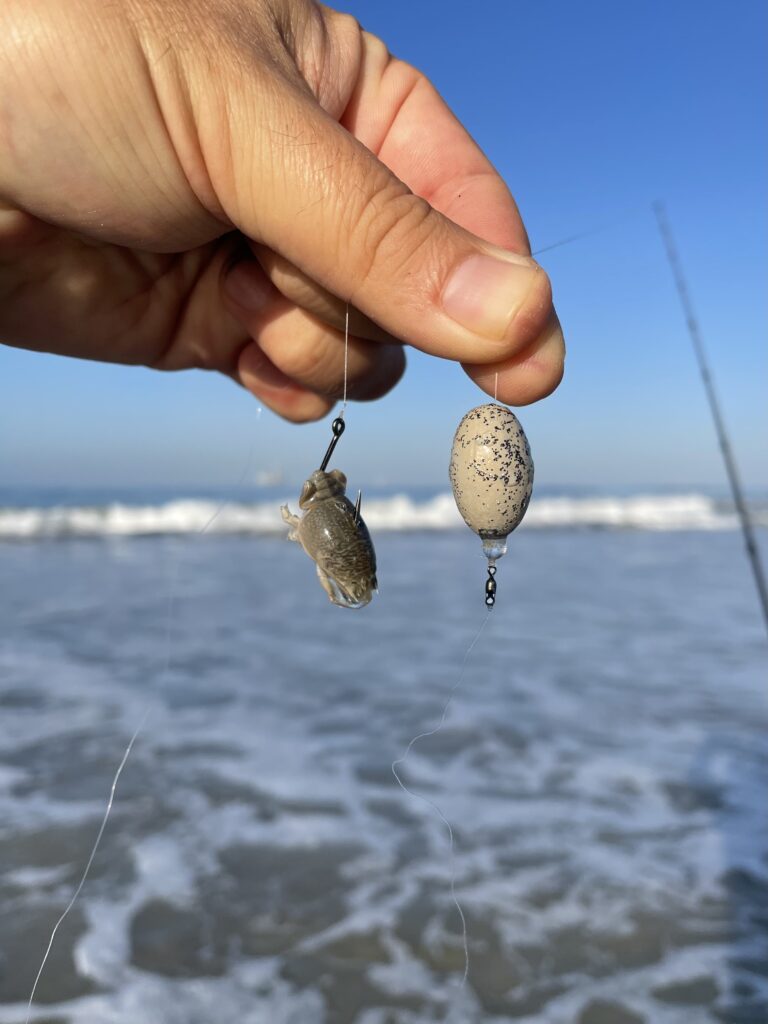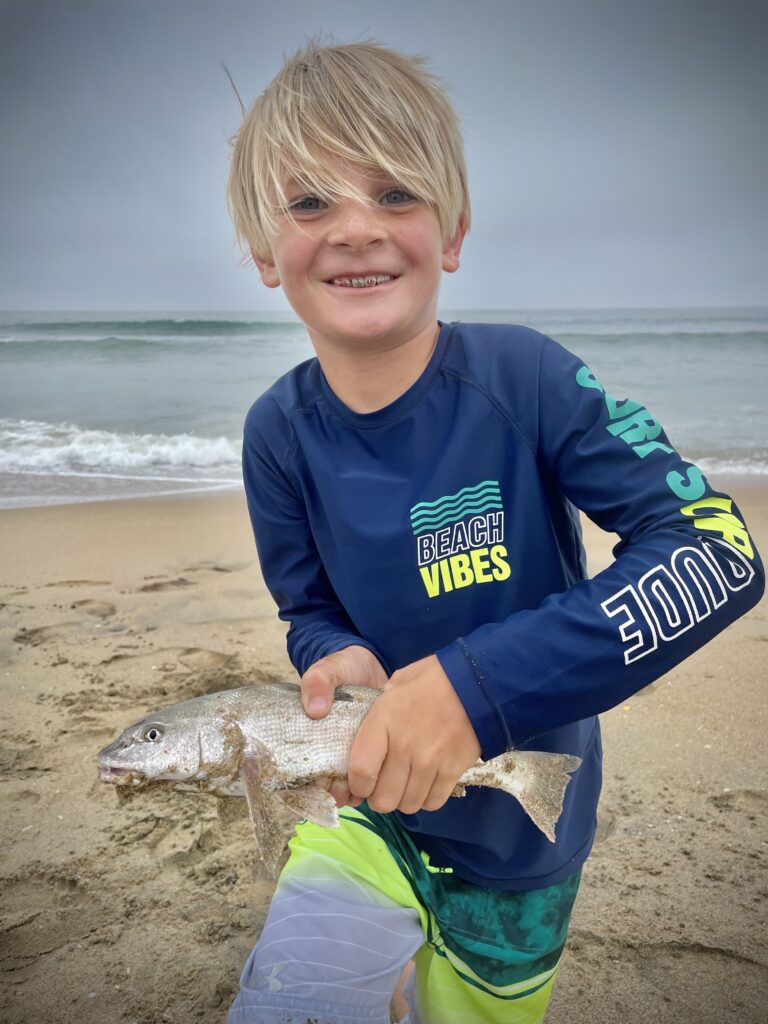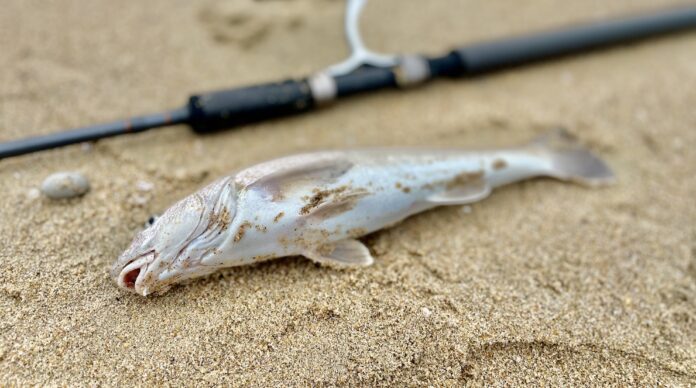BY BEN HERVEY-MURRAY
1 Use the right tackle and rig
The first step to regularly landing quality corbina out of the surf is to make sure you’re set up correctly before you even leave the house. Over a few years of guiding clients when light line fishing for corbina, surf perch and similar species, I’ve developed a few rules around rigs and tackle based on what I’ve seen working, or otherwise, that I’ll happily share.
Let’s start with the rod and reel. Leave your 7-foot trout combo at home and go with a specialist rod at least 9-foot in length and rated for 4- to 10-pound line, or very similar. The extra length in the rod will help you manage your line and keep the sinker in the right zone for longer compared to a short rod.
I currently own three Okuma SST 9-foot 6-inch rods for my personal use and client sessions and can’t fault their combination of quality and value when it comes to this style of fishing. The model number you need is SST-S-962L-CGa, by the way.
Reel-wise, buy the best you can afford. I currently use a mixture of Penn Battle 3 2500 DX and Penn Slammer IV DX models loaded with 10-pound braid. I’ve veered more towards Penn reels in recent seasons – Slammer models in particular due to their high level of sealing tech – because I find they just last forever and work regardless of what you throw at them.
I frequently guide young anglers or beginners, and they might not understand that dunking a reel in the sandy shore break is bad news for most reels (but good news for my reel servicing guy…) so something that can take some punishment and carry on fishing is a welcome attribute.
So, go for the reel with the highest level of sealing you can afford. I’m not saying you should blow the rent money on an $800 Van Staal, but a $300 Slammer IV will be a superb reel for many seasons with little maintenance required, whereas a standard $100 reel like a Daiwa BG will need a service or two and, likely, some replacement parts in the same period due to the inevitable incursion of salt and sand. That’s my experience, anyway.
Another factor to consider is the quality of the drag mechanism. The Penn HT-100 system holds up really well and doesn’t stick or become jerky, even after a sand bath. This really matters when it comes to corbina fishing; those long, drag-pulling runs must be handled by the reel in such a way that it doesn’t lock or bind due to sand in the drag. I’ve seen lesser reels lose significant fish due to this issue.
Lastly, the rigging is critical, too. Having tried many variations back-to-back, I’ve arrived at the following set-up as my go-to for summer corbina. First, 10-pound braid main line (one of the new generation of smooth casting braids in moss green), then enough 6 or 8-pound fluorocarbon so the leader knot (the connection between the fluorocarbon and braid – a back-to-back uni knot in this case) just sits on the spool when teeing up a cast. With a 9-foot rod, that’s about 11 foot of leader.
I’ve found this leader to be pretty important. Catches fell noticeably when I’ve done without it. Think of how a corbina finds its food – scoping tiny items like sand crabs and worms in the turbulent shore break… To feed successfully, they must have evolved incredible eyesight to pick out a tiny sand crab in the sandy maelstrom. Thus, your braid or mono main line must look like an abomination floating around their feeding area, whereas fluorocarbon with its refractive index similar to water is much more subtle.
From the fluorocarbon leader, I run a ¾-ounce egg sinker (or 1/2-ounce if its flat calm) down to a tiny clear bead, small stainless steel swivel and 30 inches of 6-pound fluorocarbon leader with a size 8 hook. Everything is kept as subtle and discreet as possible – I don’t want the corbina seeing anything other than my hook bait.
2 Small baits for big fish
The temptation is always to hook on the biggest sand crab you can find and cast that out. No doubt this will work some of the time, maybe picking up a trophy or two, but more frequently it’ll either come back chomped in half or missing.
Nearly every single big corbina I’ve ever caught has been on bunches of smaller crabs; usually three or four samples the size of a small pea or grain of baby corn. This creates a bait that’ll cast further than one larger crab, and fish will readily inhale the whole lot, leading to more hook ups. Plus, if you do miss a bite or a small surf perch crunches one off the hook, you’re still going to get bites because the rest of the crabs are enough to get the interest.
The only time I use a big sand crab is when I find a soft shell variety. The fish seem to inhale these more readily – maybe that soft shell allows them to squish it a little so the whole lot enters the mouth a little easier than compared to a hard shell model. Or maybe the extra juices and chemical signatures given off by a molting crab is the X-factor that fish can’t resist. Either way, if you see an off-color crab in the sieve that’s soft to touch, use that one first or whenever you’re on fish but can’t seem to get any takers.

I hook small sand crabs by skewering one or two on the shank of the hook, and two on the bend, leaving the hook point exposed. Bigger soft shell jobs are rigged more like a tiny soft plastic bait, with the hook coming up through the little digging spike on the underside and the point just emerging from the middle of the main shell. Just like fishing a weedless bait for bass, the corbina and similar species have no problem in squashing the softer bait enough to release that hook point.
Also, note that a small sandworm grub bait is pretty effective when you can’t find crabs for bait. I’m very happy to use this in winter and regularly catch corbina on the 1-inch sections of camo neris variety of the Berkley Gulp! Sandworm range.
3 Relationship between sinker, line and rod
This is easily the most critical part of light line surf fishing that isn’t talked or written about much. Just cast out, slowly reel in and wait for a bite, right? That’ll work some of the time, but more frequently you’ll miss bites as fish pick up the bait and quickly work out something isn’t right before the angler has any clue what’s going on. I see it time and again with guided clients who are on their first session.
So, let’s explore what we mean by managing the relationship between sinker, line and rod. First, consider an average day on a SoCal beach with a mild breeze, 1- to 2-foot waves and a little current. The average beginner is going to cast that ¾-ounce egg sinker out into the breakers, and maybe pause for a few seconds whilst they flip the bale arm back over and get themselves set.
In this time, the waves, current and wind will all have a significant impact on what the line and sinker is doing. The current will drag the line (and sinker) along the beach, the waves will push the whole lot back to shore and wind is likely doing something else to the main line. All of these factor conspire to create a lot of slack line and almost zero direct contact between the angler and bait. So, not only will it be really hard to feel when a fish picks up the bait with this lack of contact, but we’ve also created a most unnatural presentation with the hook bait moving faster than the current or waves would normally be washing food items around. This a big red flag for a corbina.
By contrast, the more experienced corbina angler will know that maintaining a straight line between rod tip and sinker is crucial to feeling the bite and setting the hook. Plus, even if the sinker is bouncing down the current, keeping in direct contact with it will keep the rig in the bite zone (a trough or hole, for example) for longer and offer more opportunities for hook-ups.
The best way to achieve this consistent, direct contact between rod and bait is through great line management. When casting, this means putting a finger on the spool when the rig is a foot or two above the surface of the water at the end of its trajectory, which straightens out the main line and lets the rig land in a tangle-free manner. Then, immediately flip the bail arm and grab a few turns of line on the reel to maintain that straight line and direct contact. Holding the rod up high, pointing at the clouds, helps keep the super-thin braid off the water and gives you a bit of leeway to set the hook too. At no point should the line between rod tip and sinker be slack.
Get used to anticipating the movement of the water as the waves come in, stopping a slow retrieve between sets when the water isn’t moving, and grabbing a few turns when the wave begins to move everything towards the beach. Keep the rod tip high – just bent with the load of the sinker – and give the occasional flick when the line gets bedded down into the foamy stuff. This lifts it off the water and out of the influence of current and wave, aiding that direct contact.
4 Sight fishing vs fishing over sand crab beds
Whilst there’s no doubt that sight fishing a corbina is one of the most satisfying strands of surf fishing, it’s also one of the hardest things to achieve. The fly guys who specialize in this have a pretty poor hit rate in terms of fish per session, if they’re honest. You need everything to be working in your favor and a high degree of skill in casting and not spooking them.

I’ve found that a far more reliable way of catching them, is to be fishing with the tactics described above and targeting large beds of sand crabs, regularly hoping between the larger patches that pop up on our sand beaches during the warmer months. The real gold is here is finding those mega, room-size beds rather than little patches. In summer, I target these areas nearly exclusively, largely ignoring structure when it comes to corbina.
That’s not to say you won’t frequently see them and that this isn’t a big clue on where to fish. A recent session illustrated this well; we pitched up next to a large bed of crabs, casting a bunch of small crabs into the breakers whilst stood in the middle of the bed. First cast, we saw a corbina come in with the wave, turn and swim back out. For my client’s next cast, I put on a soft shell crab and we hooked a very similarly-sized corbina a few seconds after casting blind into the surf adjacent to where we saw the fish. This is a pretty typical scenario in the summer. Look for the clues and you will find them, even if they’re not obviously there.
5 Tides and session planning
On my calendar, I mark likely tides and session windows well in advance and this allows me to plan a session around optimal conditions. For corbina, ideally I look for a small swell (1- to 3-foot) and an outgoing tide a couple of hours after the high until an hour off the low – a state that leaves lots of sand crabs exposed whilst still offering enough water close to shore on the average beach to keep the fish within casting range. Timing-wise, dawn is the time to be out there and I like to be home and hosed by the time the crowds, surfers and wind builds around mid to late-morning.
Peak seasons are June through to Thanksgiving, but I’ve caught corbina all year round and there’s definitely a small resident population in various SoCal harbors. When the water temperature hits 63-degrees, that’s usually when the mass of sand crabs turn up along with the corbina, so follow that data point and you’ll have a good idea when it’s go-time for this fascinating species.




